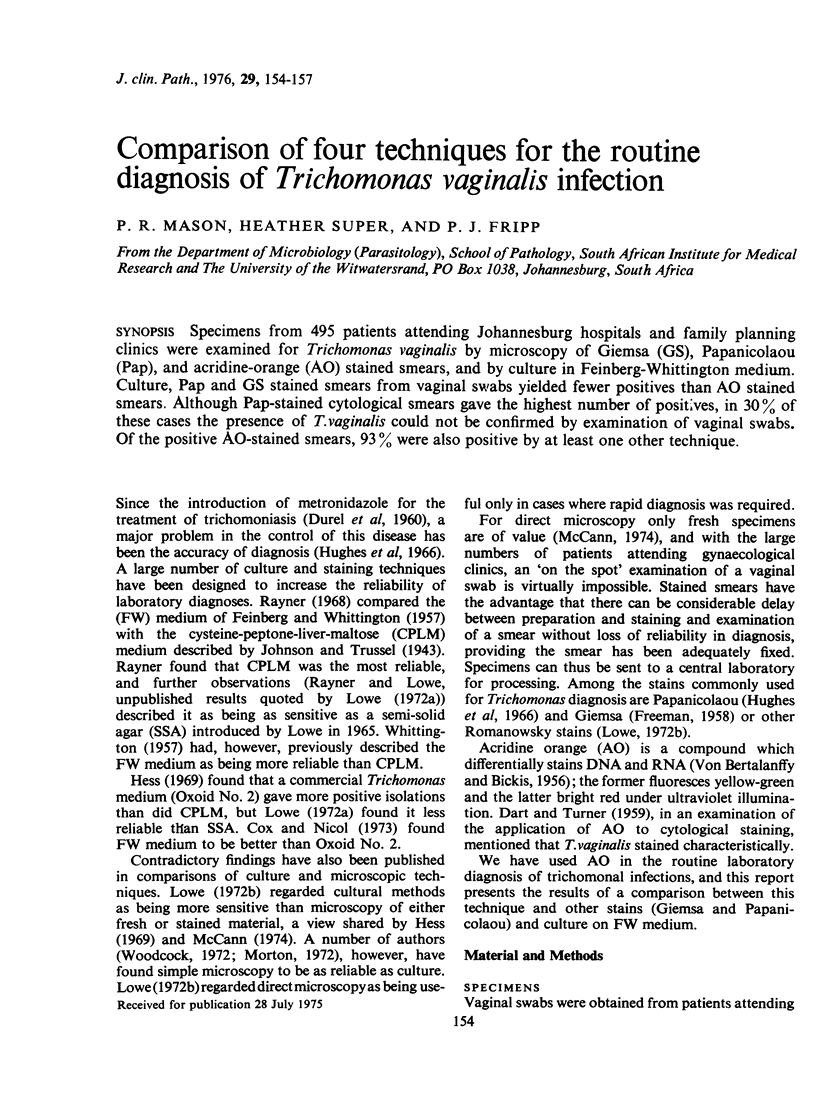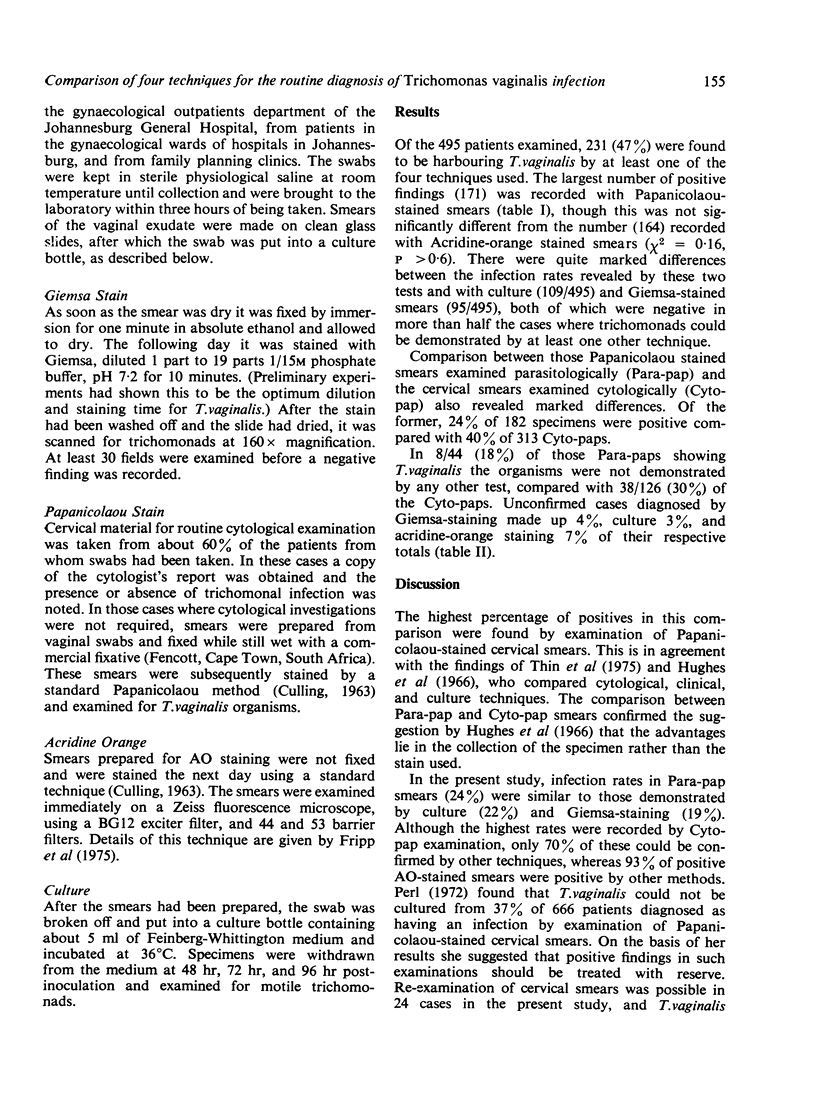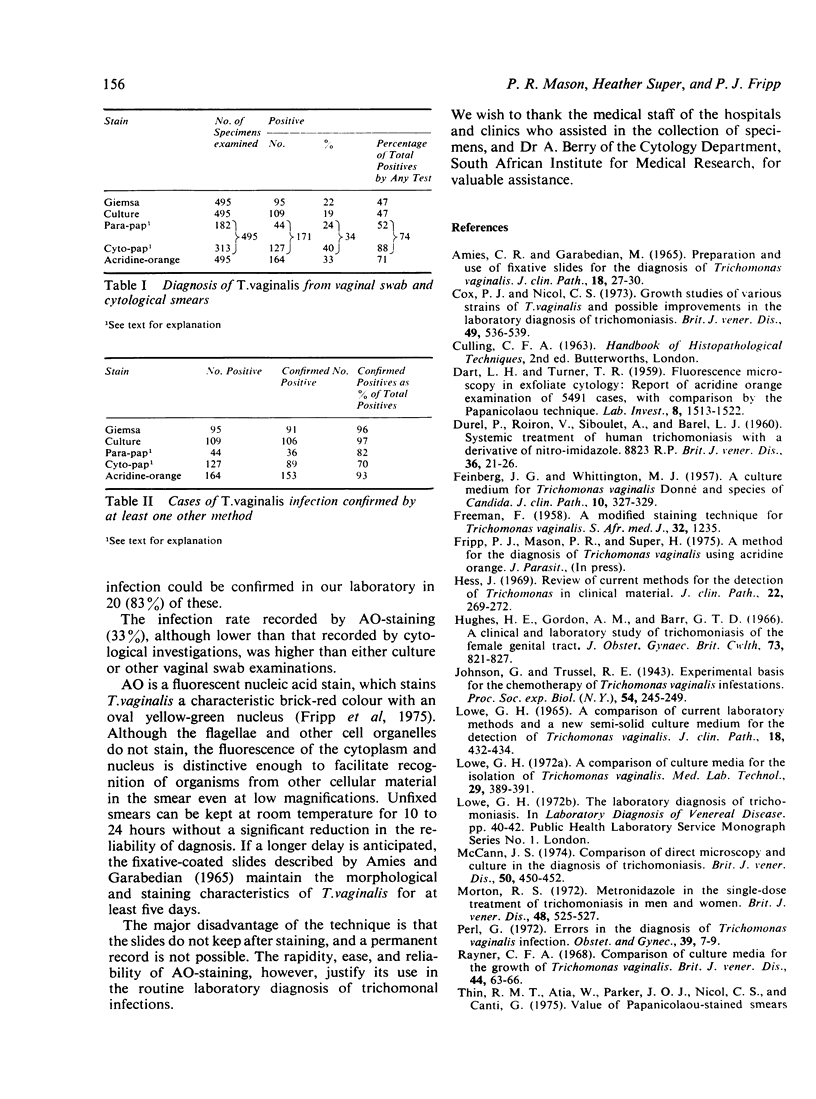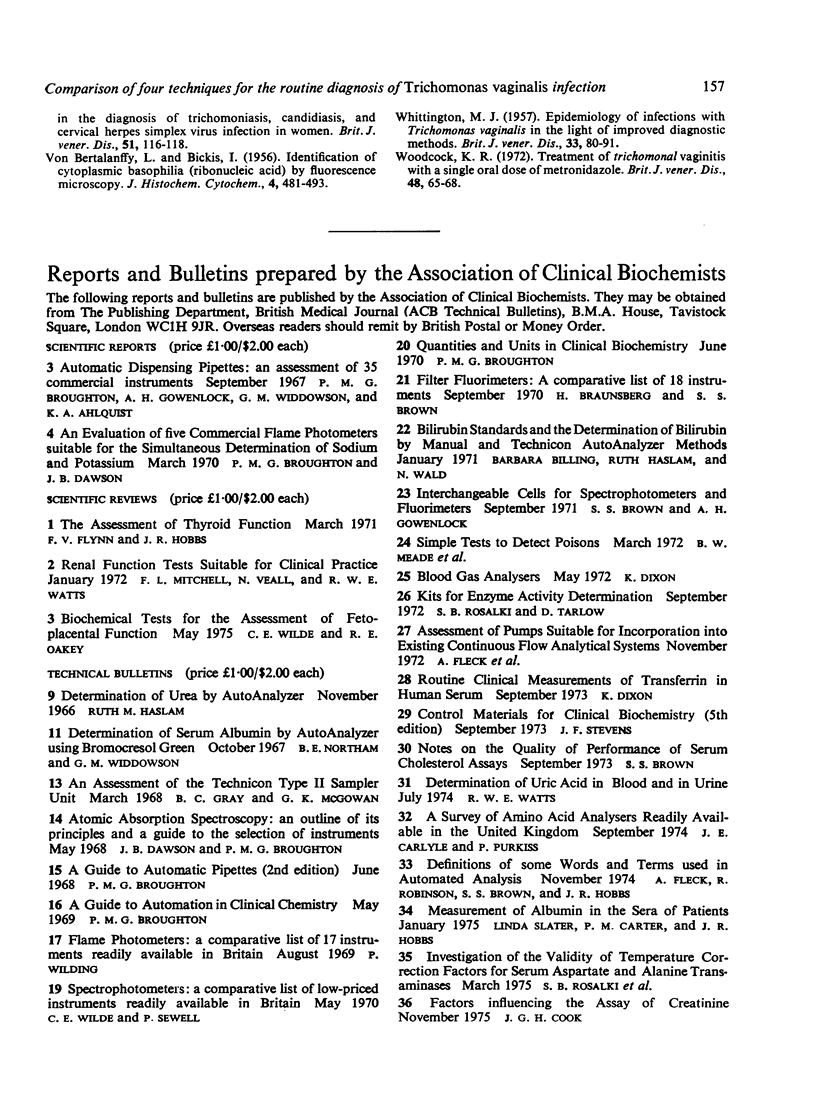Abstract
Specimens from 495 patients attending Johannesburg hospitals and family planning clinics were examined for Trichomonas vaginalis by microscopy of Giemsa (GS), Papanicolaou (PAP), and acridine-orange (AO) stained smears, and by culture in Feinberg-Whittington medium. Culture, Pap and GS stained smears from vaginal swabs yielded fewer positives than AO stained smears. Although Pap-stained cytological smears gave the highest number of positives, in 30% of these cases the presence of T.vaginalis could not be confirmed by examination of vaginal swabs. Of the positive AO-stained smears, 93% were also positive by at least one other technique.
Full text
PDF



Selected References
These references are in PubMed. This may not be the complete list of references from this article.
- AMIES C. R., GARABEDIAN M. PREPARATION AND USE OF FIXATIVE SLIDES FOR THE DIAGNOSIS OF TRICHOMONAS VAGINALIS. J Clin Pathol. 1965 Jan;18:27–30. doi: 10.1136/jcp.18.1.27. [DOI] [PMC free article] [PubMed] [Google Scholar]
- BICKIS I., VON BERTALANFFY L. Identification of cytoplasmic basophilia (ribonucleic acid) by fluorescence microscopy. J Histochem Cytochem. 1956 Sep;4(5):481–493. doi: 10.1177/4.5.481. [DOI] [PubMed] [Google Scholar]
- Cox P. J., Nicol C. S. Growth studies of various strains of T. vaginalis and possible improvements in the laboratory diagnosis of trichomoniasis. Br J Vener Dis. 1973 Dec;49(6):536–539. doi: 10.1136/sti.49.6.536. [DOI] [PMC free article] [PubMed] [Google Scholar]
- DART L. H., Jr, TURNER T. R. Fluorescence microscopy in exfoliative cytology. Report of acridine orange examination of 5491 cases, with comparison by the Papanicolaou technic. Lab Invest. 1959 Nov-Dec;8:1513–1522. [PubMed] [Google Scholar]
- DUREL P., ROIRON V., SIBOULET A., BOREL L. J. Systemic treatment of human trichomoniasis with a derivative of nitro-imidazole, 8823 RP. Br J Vener Dis. 1960 Mar;36:21–26. doi: 10.1136/sti.36.1.21. [DOI] [PMC free article] [PubMed] [Google Scholar]
- FEINBERG J. G., WHITTINGTON M. J. A culture medium for Trichomonas vaginalis donné and species of Candida. J Clin Pathol. 1957 Nov;10(4):327–329. doi: 10.1136/jcp.10.4.327. [DOI] [PMC free article] [PubMed] [Google Scholar]
- FREEMAN F. A modified staining technique for Trichomonas vaginalis. S Afr Med J. 1958 Dec 27;32(52):1235–1235. [PubMed] [Google Scholar]
- Hess J. Review of current methods for the detection of Trichomonas in clinical material. J Clin Pathol. 1969 May;22(3):269–272. doi: 10.1136/jcp.22.3.269. [DOI] [PMC free article] [PubMed] [Google Scholar]
- Hughes H. E., Gordon A. M., Barr G. T. A clinical and laboratory study of trichomoniasis of the female genital tract. J Obstet Gynaecol Br Commonw. 1966 Oct;73(5):821–827. doi: 10.1111/j.1471-0528.1966.tb06091.x. [DOI] [PubMed] [Google Scholar]
- LOWE G. H. A COMPARISON OF CURRENT LABORATORY METHODS AND A NEW SEMI-SOLID CULTURE MEDIUM FOR THE DETECTION OF TRICHOMONAS VAGINALIS. J Clin Pathol. 1965 Jul;18:432–434. doi: 10.1136/jcp.18.4.432. [DOI] [PMC free article] [PubMed] [Google Scholar]
- Lowe G. H. A comparison of culture media for the isolation of Trichomonas vaginalis. Med Lab Technol. 1972 Oct;29(4):389–391. [PubMed] [Google Scholar]
- McCann J. S. Comparison of direct microscopy and culture in the diagnosis of trichomoniasis. Br J Vener Dis. 1974 Dec;50(6):450–452. doi: 10.1136/sti.50.6.450. [DOI] [PMC free article] [PubMed] [Google Scholar]
- Morton R. S. Metronidazole in the single-dose treatment of trichomoniasis in men and women. Br J Vener Dis. 1972 Dec;48(6):525–527. doi: 10.1136/sti.48.6.525. [DOI] [PMC free article] [PubMed] [Google Scholar]
- Perl G. Errors in the diagnosis of trichomonas vaginalis infections as observed among 1199 patients. Obstet Gynecol. 1972 Jan;39(1):7–9. [PubMed] [Google Scholar]
- Rayner C. F. Comparison of culture media for the growth of Trichomonas vaginalis. Br J Vener Dis. 1968 Mar;44(1):63–66. doi: 10.1136/sti.44.1.63. [DOI] [PMC free article] [PubMed] [Google Scholar]
- Thin R. N., Atia W., Parker J. D., Nicol C. S., Canti G. Value of Papanicolaou-stained smears in the diagnosis of trichomoniasis, candidiasis, and cervical herpes simplex virus infection in women. Br J Vener Dis. 1975 Apr;51(2):116–118. doi: 10.1136/sti.51.2.116. [DOI] [PMC free article] [PubMed] [Google Scholar]
- WHITTINGTON M. J. Epidemiology of infections with Trichomonas vaginalis in the light of improved diagnostic methods. Br J Vener Dis. 1957 Jun;33(2):80–91. doi: 10.1136/sti.33.2.80. [DOI] [PMC free article] [PubMed] [Google Scholar]
- Woodcock K. R. Treatment of trichomonal vaginitis with a single oral dose of metronidazole. Br J Vener Dis. 1972 Feb;48(1):65–68. doi: 10.1136/sti.48.1.65. [DOI] [PMC free article] [PubMed] [Google Scholar]


